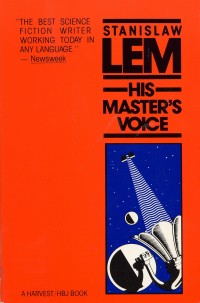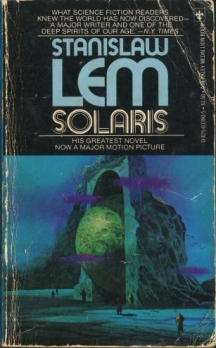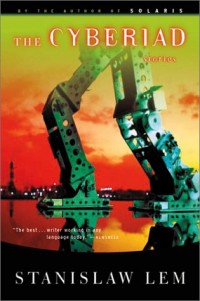25 Points: His Master’s Voice
 |
His Master’s Voice
by Stanislaw Lem
Northwestern University Press, 1999
199 pages / $16.95 buy from Amazon
|
1. I first read Stanislaw Lem after seeing an anonymous review of The Cyberiad on HTMLGIANT.
2. I’ve read two of his books. A year or two ago I read Solaris, then last week I read His Master’s Voice.
3. His Master’s Voice, published 7 years after Solaris, echoes the earlier book in pleasing ways. The most obvious to me was that neither ever directly answers the mystery near the heart of each book. A reader will not definitively learn the nature of the ocean on Solaris, or what the letter from the stars says.
4. HMV places human failure more centrally than Solaris. The narrator of HMV, Peter Hogarth, is (after the fact) a complete pessimist about humanity’s time facing their impossible task.
5. The book is philosophical, often profound. For example: “Our ability to adapt and therefore to accept everything is one of our greatest dangers. Creatures that are completely flexible, changeable, can have no fixed morality.”
6. Or, “Psychoanalytic doctrine reveals the pig in man, a pig saddled with a conscience; the disastrous result is that the pig is uncomfortable beneath that pious rider, and the rider fares no better in the situation, since his endeavor is not only to tame the pig but also to render it invisible.” Hogarth does not have much love for psychoanalysis throughout the book.
7. Lem would eventually focus most of his effort on writing philosophical essays and abandon the novel. Knowing this made it hard to separate Lem and Hogarth during these tangents.
8. Something I find particularly engaging about Lem’s writing is his way of introducing the reader to complex scientific and technological ideas on which he was likely not an actual expert, and doing so with authority. I’ll come back to this.
9. At one point in the book Lem uses Hogarth and another of his characters as mouthpieces for his own personal views of pulp science fiction. Lem was famously not a fan of most of his contemporary genre writers, and when the character Rappaport hits a wall in his research he resorts to reading a stack of apparently mediocre SF—“expecting variety, finding monotony.”
10. One of several reasons Lem gave for no longer writing fiction was his inability to keep up with the increasing number of papers being written on the cutting edge of science. This meant that he could no longer keep writing books involving cutting edge ideas with the sense of authority I earlier admired. Maybe he feared that without that he would be just another indistinguishable pulp science fiction author.
July 3rd, 2014 / 12:00 pm
Watching, owning, looking at, listening to, thinking about, and at last finally reading Solaris
 I adore Stanisław Lem. And for ages I’ve wanted to read his masterpiece Solaris (1961), but haven’t, even though I own a couple of beat-up mass paperback copies, because the only English translation available has been the Joanna Kilmartin and Steve Cox 1970 adaptation, which they “translated from the French”—from Jean-Michel Jasiensko’s 1966 translation—and which Lem himself purportedly disliked, and which my Polish friends have repeatedly told me is terrible, and which I’ve nonetheless tried to read on a number of occasions, but was never able to get more than a few pages into before I’d give up and instead rewatch Andrei Tarkovsky’s 1972 cinematic adaptation (which Lem also openly disliked; the man wasn’t afraid to voice his opinions). (And even with that film, it wasn’t until I saw Criterion’s 2002 DVD release that I realized how magnificent it was; the 1997 VHS release was washed out and split across two tapes, and I think even pan-and-scanned, rendering it pretty underwhelming.)
I adore Stanisław Lem. And for ages I’ve wanted to read his masterpiece Solaris (1961), but haven’t, even though I own a couple of beat-up mass paperback copies, because the only English translation available has been the Joanna Kilmartin and Steve Cox 1970 adaptation, which they “translated from the French”—from Jean-Michel Jasiensko’s 1966 translation—and which Lem himself purportedly disliked, and which my Polish friends have repeatedly told me is terrible, and which I’ve nonetheless tried to read on a number of occasions, but was never able to get more than a few pages into before I’d give up and instead rewatch Andrei Tarkovsky’s 1972 cinematic adaptation (which Lem also openly disliked; the man wasn’t afraid to voice his opinions). (And even with that film, it wasn’t until I saw Criterion’s 2002 DVD release that I realized how magnificent it was; the 1997 VHS release was washed out and split across two tapes, and I think even pan-and-scanned, rendering it pretty underwhelming.)
Today I noticed that there’s a new and direct translation of Solaris available, albeit only electronically (and as an audio book). It’s by Bill Johnston, “a professor of Comparative Literature at Indiana University.” (The audio book version is read by Alessandro Juliani, who I see played Lt. Felix Gaeta on Battlestar Galactica.) … So has anyone out there read it, or listened to it? (This new Solaris, not BG.) From what I can see online, it certainly looks more promising. Here’s Kilmartin/Cox:
At 19.00 hours, ship’s time, I made my way to the launching bay. The men around the shaft stood aside to let me pass, and I climbed down into the capsule. Inside the narrow cockpit, there was scarcely room to move. I attached the hose to the valve on my space suit and inflated it rapidly. From then on, I was incapable of making the smallest movement. There I stood, or rather hung suspended, enveloped in my pneumatic suit and yoke to the metal hull.
And here, by way of contrast, is the start of Johnston’s new edition:
At nineteen hundred hours ship’s time I climbed down the metal ladder past the bays on either side into the capsule. Inside, there was just enough room to raise my elbows. After I attached the end of the cables into the port jutting from the side of the capsule, my space suit filled with air and from that point on I couldn’t make the slightest movement. I stood, or rather hung suspended, in a bed of air, all of one piece with my metal shell.
Finally, while on the subject of Solaris, has anyone out there seen that other movie version that got made? You know—the one by Lidiya Ishimbayeva and Boris Nirenburg?
Thinking about all these different editions of Solaris got me wondering what the original Polish movie poster for Solaris looked like. If you’ve become curious as well, then wonder no longer:
The Cyberiad
 The Cyberiad
The Cyberiad
by Stanislaw Lem
Mariner Books, 2002
312 pages / $13.00 buy from Powell’s
Rating: 8.5
The Cyberiad is labeled as science fiction, but it exists in a world where science is no longer distinguishable from magic. The stories in the book take place in a kind of robot Middle Ages, with mad mechanical kings on tiny planet kingdoms, electronic knights and maidens, and two brilliant constructors named Trurl and Klapaucius who travel from world to world, fabricating wonderfully implausible machines to perform various tasks, from writing brilliant poetry (yes, the robot succeeds in doing this) to distracting a lovelorn king with a “femfatalatron.”
January 3rd, 2012 / 12:09 pm
